
In this article we'll give you an overview of Google Analytics (GA) and how you can set up the basics for your B2B Marketing analytics configuration and make sure you are recording the right actions on your B2B website.
Google Analytics vs Google Analytics 4
With the introduction of GA4 (Google Analytics 4) GA has moved to an event based approach to analytics. Previously in the old GA events were set up in response to recording specific actions being taken where as now in GA4 everything is treated as an event. This is the main thing to consider with GA4 beyond the new user interface and reporting.

There are plenty of other changes in GA4 but from our experience you don't need to know all of these elements right now. You can read in more detail about all the new changes in this support article from Google themselves.
Setting up Google Analytics
We recommend setting up Google Analytics via Google Tag Manager. This means you only need to install Google Tag Manager on your website and then you can add Google Analytics and all your other code injections such as LinkedIn Insights tag and Facebook Pixels into Google Tag Manger (GTM). GTM is the best choice for B2B marketers because you will usually have more tools to add into your website such as Google Ads and Hotjar to name two popular ones.
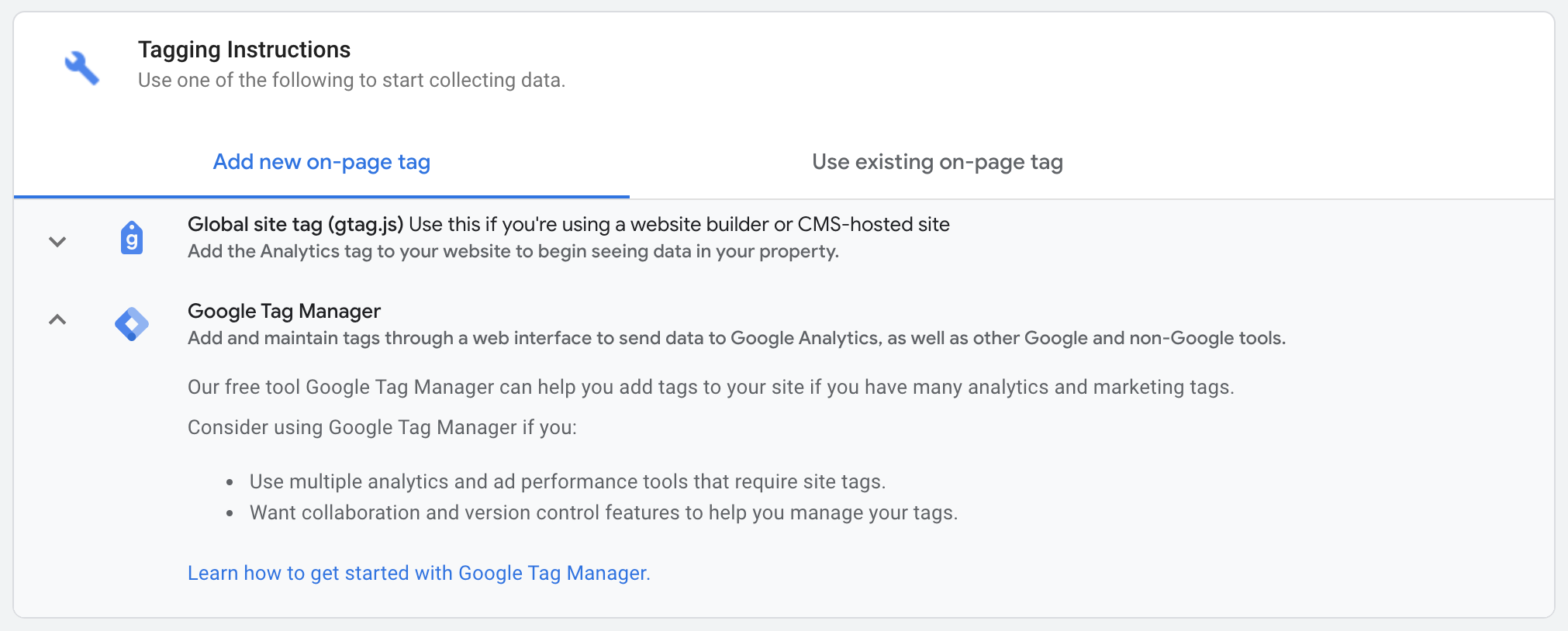
Tag Manager Set up & Installation
The first thing to do to configure your analytics system is to create a Google Tag Manager account and container. If you need some guidance then you can follow this set up guide from Google.
What is Google Tag Manager?
Google Tag Manager (GTM) is a tag management system that allows you to manage all of your tags and scripts under one roof rather than requiring a developer to add codes to your website every-time you want to make an adjustment to your analytics and tracking system. You will potentially need a developers help to initially install Tag Manager, but once this is done you should be able to do the rest your self from within GTM.
I would recommend installing GA4 via Google Tag Manager as it is quick and easy and gives you full control. You should set up a new container for each website or application you want to measure, this gives you the ability to have different elements installed on different websites.

Components of Google Tag Manager
There is a useful support article on the Google website that explains this in more detail but in essences this are the main components of your Google Tag Manager account and how it works.
- Tag: A tag is code that send data to a system such as Google Analytics.
- Trigger: A trigger listens for certain events, such as clicks, form submissions, or page loads. When an event is detected that matches the trigger definition, any tags that reference that trigger will fire.
- Variable: A variable is a named placeholder for a value that will change, such as a product name, a price value, or a date.
- Data layer: Tag manager implements a data layer to temporarily hold values in the client so that they can be used by tags, triggers, and variables.
Installing Google Analytics Via Tag Manager
Install GA via GTM is super quick and easy. Once GTM is installed on your website you need to create a Tag and paste your google analytics ID into it. You can do this by selecting 'New Tag' and the selecting 'Google Analytics:GA4 Configuration' from the list on the right side.

Next you will be asked to supply your measurement ID. You can grab this from the setup assistant in your Google Analytics account. You simply copy the ID using the button on the right side of screen.

Once you have this copied you can go back into Google Tag Manager and paste your measurement ID into the appropriate box which hopefully should be pretty obvious.
There are other options you can set in here but both the most common configuration you don't need to do anything else at this point.
The next thing you need to do is add a trigger so that your Google Analytics tag fires. The most common configuration for this is to fire it on every page on your website. This is because most marketeers want to track all of the pages on your website.
If you want to you can configure your analytics tag to only fire on certain pages if you want to ignore certain pages from your data.

Once this is done and you have published your container (don't forget this part) your GA4 account will be live on your website.
Cross-domain tracking in GA4
Cross-domain tracking in GA4 enables you to view analytical data from multiple websites under one analytics view. This is useful if you are running 2 different websites and want the analytics from these sites to viewed under one analytics property. It allows you to track the user journey from one domain to another. For example if you have a main corporate website that links to an online shop you may want to track the user journey across both domains. Cross-domain tracking transfers the Google Session ID and User ID from the first website to the second so you can get a complete view of the user journey.
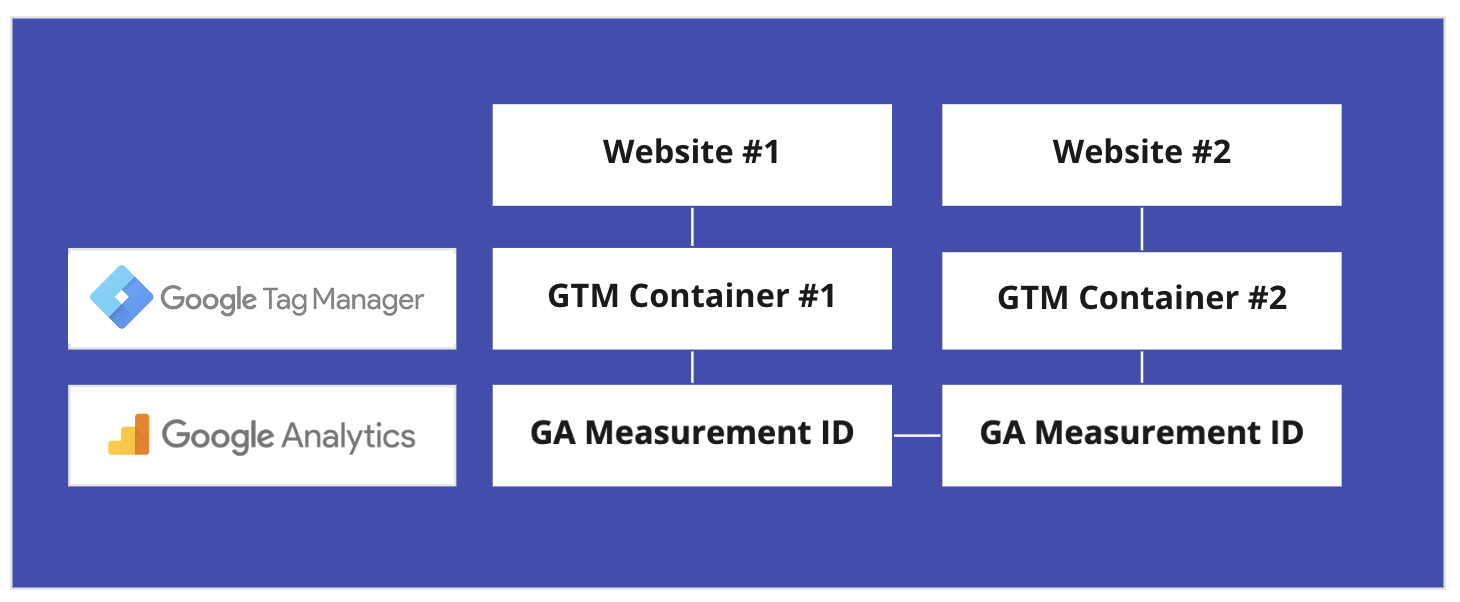
Important: You need to use the same ID on all of your websites for this to work correctly. This means installing the same GA ID on all relevant websites. Once done you can configure your data streams to include the relevant domains.
You can do this by going into your GA account and then going to data streams. You should just have one data stream in here if you have a standard set up.

Once you are on this screen you should click on your data stream and scroll down to the bottom of the page. Here you will see "More Tagging Settings". Click on this to take you to the next screen.

On this page you can then select "Configure your domains". You can also define internal IP addresses which is useful to do so that your not picking up your employees visiting your website.

On the configuration screen you can add the domains you want to track. Using the 'Contains' match type is probably the easiest way to add domains. It's worth noting that using this method also picks up subdomains.

Tracking Events and Conversions
Once you have your Google Analytics Property set up it's time to configure your event and conversion tracking in accordance with what the most important calls to action are on your website. Beyond seeing how many people visit your website and which pages they interact with you should be looking to track when someone takes an intended action on your website. This means tracking events such as 'contact us' form submissions and CTA button clicks.
Step 1: Event Mapping
Before you start jumping into GA and GTM it is worth spending some time to map out exactly what you want to track and why it is important to you and your business goals. I have embedded an example of an analytics event map to give you an example of some of the basics.
.jpeg)
Step 2: Event Configuration
The next step is start configuring these events in Google Tag Manager so that they can pulled into Google Analytics. To do this you need to create a new tag within GTM, this tag will fire when you link it to a trigger, the trigger is what we have mapped out in the "what unique event can measure it?" column. When this unique event happens the tag will fire and create the event in your Google Analytics account.


Tracking Form Submissions
I've singled out form submissions as they can sometimes be the most difficult element on a B2B website to track depending on how you have it configured. I would strongly recommend that you configure your web forms to redirect users to a 'Thank You Page' on successful submission. This means when someone reaches the page /confirmation as an example it is a simple page view event you have to track.
Issues can also arise when your website forms are embedded on your website with an IFRAME, this is a common problem with tools such as Pardot and sometimes HubSpot too.
Below is a screenshot showing a trigger configuration for a page view of a certain page. In old GA this could be set up from with Google Analytics itself using the 'destination' goal type. You can still configure events from with Google Analytics 4 but I would recommend setting them up this way in GTM to allow you the most flexibility and IMO it is a bit easier and tidier.

Linking your trigger to your form submission event
Now you have your trigger which is your 'unique action'. You need to link this trigger to a tag so that an event is created when this happens.
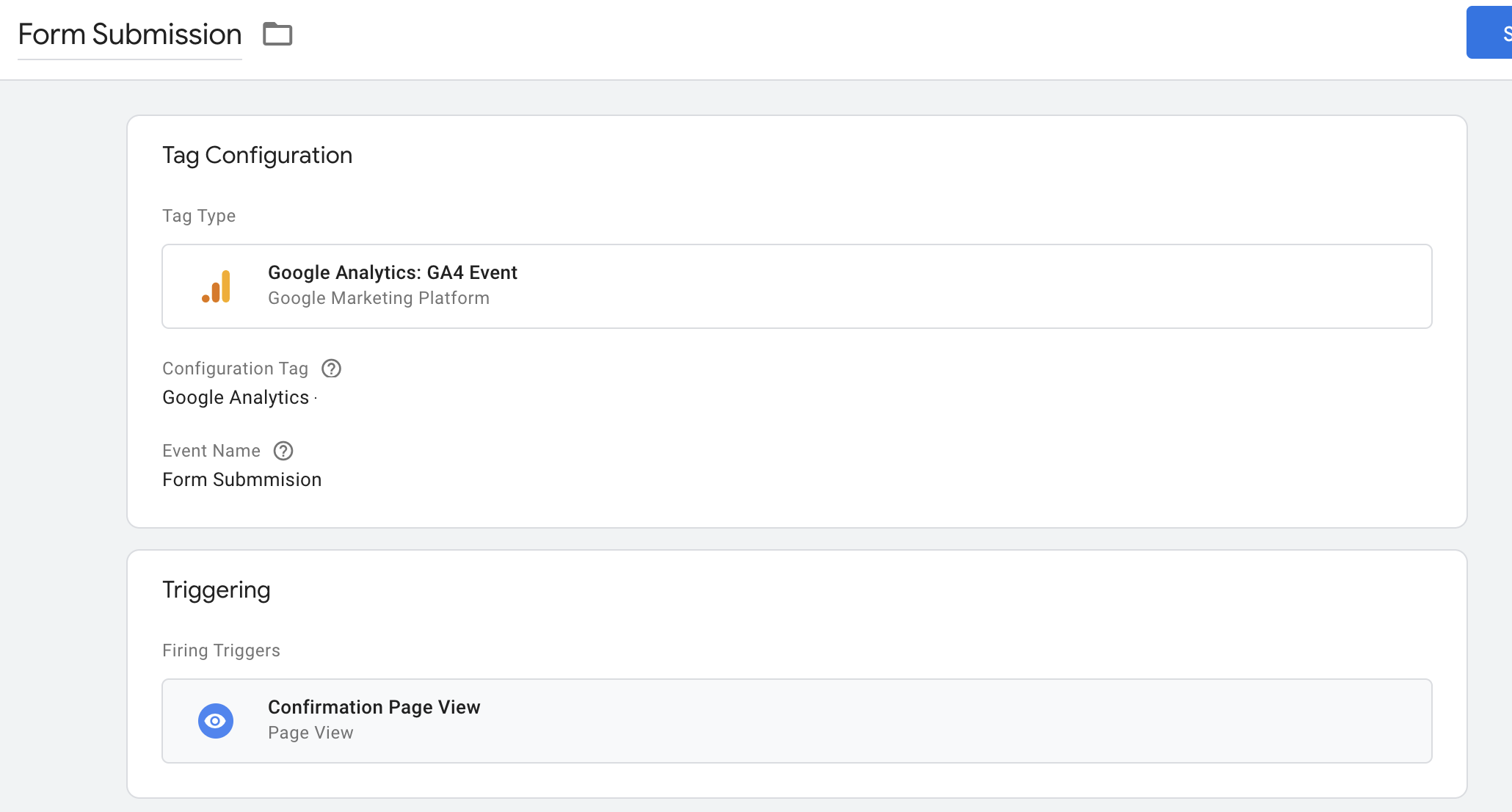
What this tag configuration means is that when that trigger of the specific page view happens, the tag will fire and it will create an event called "Form Submission" in your Google Analytics profile. It's worth mentioning here that you should try to standardise your naming conventions for your events so that it is easy to maintain as you may add more events to track different forms on your website.
Previously in GA you would have form categories, actions and labels but this is not the case anymore in Google Analytics 4.
Marking an event as a conversion in GA4
Now you have your event set up you need to decide whether or not this specific event is a conversion or not. In this case we will assume that a form submission is a key conversion goal for us and yes we do want to mark this event as a conversion in our Google Analytics profile.
To do this in Google Analytics head to Configure and then click on the Events link in the top left.
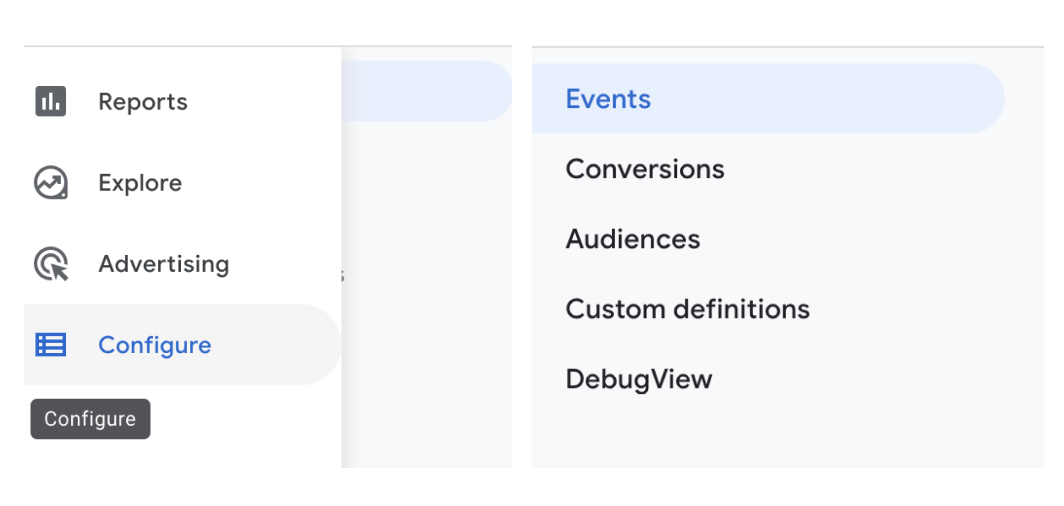
Once in the events configuration you'll see the events that are being recorded on your Google Analytics profile. Some of these are standard events that are automatically recoded by Google Analytics 4 - this is something new in GA4. Things like scroll events are new. You can see in the screenshot below i created an event called 'Get in touch' - this is essentially a form submission but I just called it this so that It is clear what it refers to.
To mark this event as a conversion you simply hit the toggle button on the right and it will turn blue. This means this event will now be tracked as a conversion in your analytics. You can toggle it on and off but if set up correctly you shouldn't ever need to turn this off.
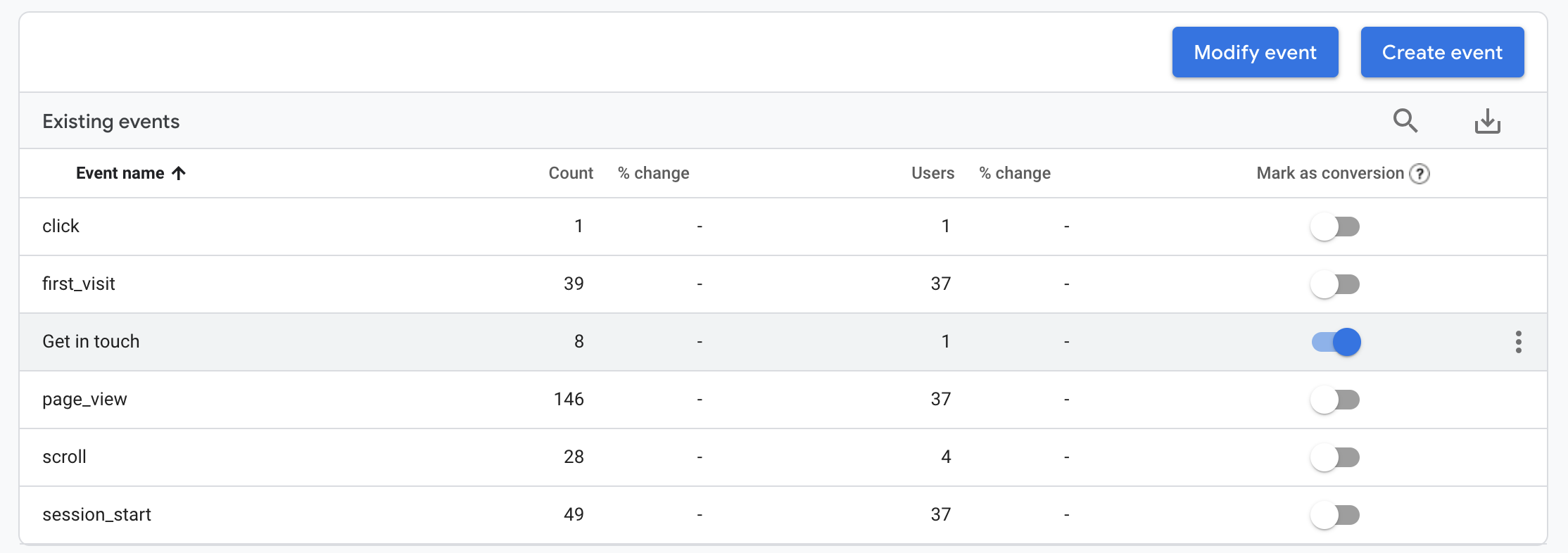
And you're done. This is simplest way to record form submission as a conversion in Google Analytics 4. As most B2B websites have form submissions as the main call to action this should be applicable to a lot of websites. This set up does assume you are using a thank you page for your form submissions. If you're not I would highly recommend you do this as it will save a lot of pain in the long run. It's also a nice positive interaction for a user so they now the form has been submitted.
Don't rely on marketing automation tools
A common mistake made by modern marketeers is relying too heavily on tools such as HubSpot and Pardot for conversion tracking. Although these tools will of course make it easy to report on form submissions because it will be brought into HubSpot you should always configure your conversions in Google Analytics because if you choose to change your CRM system or want to do some deep website analytics reviews you won't be able to do this within HubSpot or Pardot
If you need support with setting up and configuring your Google Analytics profile or want you current set-up audited by a Freelance Google Analytics Consultant please free to get in touch.
Find a B2B SaaS Expert
We've collected a directory of B2B SaaS experts and agencies that we've reviewed and categorised based on service and specialism for your review.













